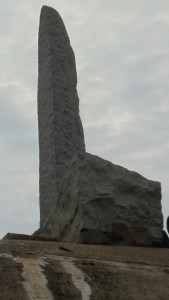
We docked in Le Havre, France, on the last day of our British Isles cruise. Le Havre is a gateway to France’s Normandy region, somewhere I’ve long wanted to jaunt. Mainly because I’ve been curious about the D-Day beaches.
I partly picked the cruise because it afforded a chance to do a Normandy/World War II excursion. I wasn’t quite sure what to expect. I figured a visit to the American Cemetery (a Movie Monday post about which is forthcoming), and maybe Omaha Beach? Yes. I got all that and more.
Like this visit to Pointe du Hoc.
At lunch during another excursion we took that cruise (in search of Nessie, another jaunt I’ll be writing about), we sat with a gentlemen who was a World War II buff. Having done the Normandy tours a couple of other times previously, he shared a little of what we could expect to see. He was very enthusiastic about the Pointe du Hoc portion.
As I explain in the video, Pointe du Hoc sits on a promontory overlooking the English Channel. When the Germans invaded and occupied France, this was a very strategic point to hold. It overlooked the beaches where landings were likely to be made.
Which as we know they were. Pointe du Hoc sits between what came to be known as Omaha and Utah Beaches, or the American beaches in the Allied D-Day operations. (The British had Gold and Sword. The Canadians had Juno, which was between the British beaches.)

The Germans never expected Pointe du Hoc to be penetrable from the water, however. The Allied Forces certainly bombed the hell out of it from the air. In fact, the landscape is still pocked with bomb craters. The photo below isn’t great, but it’s representative of the many “bomb valleys” that dot the landscape at the site.

Because they were sustaining such heavy bombing, the Germans pulled back most of their heavy artillery from Pointe du Hoc, not wanting to lose it. Their intel led them to believe the Allieds would invade at Pas de Calais anyway.
Which was a rouse.
The first objective was taking control of Pointe du Hoc so the Allied Forces could land at the other beaches. Army Rangers scaled the cliffs and fought hand-to-hand combat to gain control.
I knew the history, but…Seeing where it happened and actually being there? Chilling.
I was excited about the prospect of entering my first World War II bunker, so of course I had my camera rolling to capture it. What I wasn’t prepared for was the plaque inside one of the bunkers commemorating all the Rangers who lost their lives there on June 6-8, 1944.
To say it was a humbling experience is an understatement. As I said in the video, “Blessings on their lives.” It’s not enough, but no words ever will be.
All I can offer is another Thank You to the men and women who have served, and currently serve, our country. I’m a very grateful citizen.
Courtney Mroch is a globe-trotting restless spirit who’s both possessed by wanderlust and the spirit of adventure, and obsessed with true crime, horror, the paranormal, and weird days. Perhaps it has something to do with her genes? She is related to occult royalty, after all. Marie Laveau, the famous Voodoo practitioner of New Orleans, is one of her ancestors. (Yes, really! As explained here.) That could also explain her infatuation with skeletons.
Speaking of mystical, to learn how Courtney channeled her battle with cancer to conjure up this site, check out HJ’s Origin Story.
